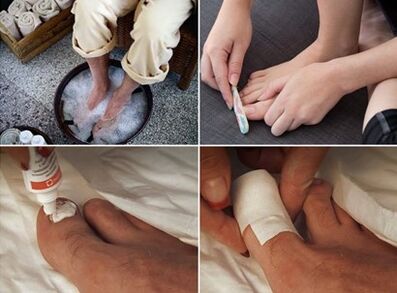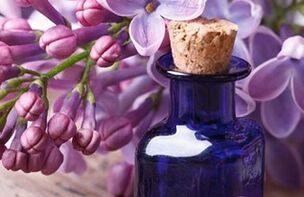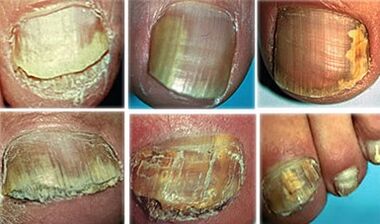Onychomycosis is a disease in which a fungal infection affects the surface of the nail plate. There are 3 types of pathogens that are most often detected in tests: fungi such as yeast, mold, dermatophytes.
Why do mushrooms appear?
The fungus itself cannot be displayed. The disease is always preceded by several motivating factors, such as:
- Use of household items with fungal spores. If a family member has onychomycosis, and others use his or her towels, slippers, or socks, the risk of infection is quite high.
- Visiting public places with a large influx of people. Sauna, spa, swimming pool, solarium, showers, fitness clubs, beaches - all of these can become a site of onychomycosis infection.
- High temperature and constant humidity of the shoes. Fungal infection often catches office workers and military personnel, who are forced to spend all day in shoes. Shortness of breath, compressed space and uncomfortable shoe patterns provoke increased sweating, blood stasis and, as a result, onychomycosis.
- Decreased immunity. If the immune system is weakened by the disease, after taking antibiotics and other reasons, onychomycosis may appear.
- Age of the person. In children, the fungus does not appear due to physiological characteristics - the infectious pathogen needs some time to gain a leg and multiply. And children’s nails grow very fast, so onychomycosis does not have time to develop. It often affects adults and almost always the elderly and the elderly. Their nail plates grow very slowly, and therefore it is especially difficult to remove the fungus on senile nails.
How do we know that nails are affected by mycosis?
When the nail plate changes in any way, this indicates potential problems. Signs of onychomycosis will be the following conditions:
- cracks between the fingers;
- yellowing of the nail plate;
- thickening of the skin;
- splitting the nail for no mechanical reason;
- burning and itching;
- folding inflamed nails;
- Thinning or thickening of the nail.
A healthy nail should be pink, shiny and soft.
Quick and effective methods of treating fungus at home
The fight against onychomycosis usually lasts at least a month. The sooner you start treatment, the sooner you will get rid of the disease. You can turn to traditional medicine, or use pharmaceutical preparations. But it is better to combine time-tested tips and effective medicines - this will allow you to quickly forget about the fungus.
Preparing the nail plate for treatment
Often, a simple application of antifungal medication does not bring the desired result. This is because medicinal substances cannot penetrate inside through thickened nails due to fungi.
Before starting treatment, the nail plate affected by onychomycosis should be removed. There are several ways to do this:
- Steam your feet in hot water. It is important to keep the water temperature high enough (up to 50 degrees) for about half an hour. To do this, you can pour dry mustard into water and constantly add new portions of hot juice. Next, you need to cut the grown part of the nail plate into steam and reduce the thickness of the nail itself with a low corrosion file (100-150 gravel).
- Buy antifungal cream paste from the pharmacy. This tool is from the budget segment, but its action can replace surgical or laser nail removal. The paste contains urea, which softens the nail plate without pain and discomfort, after which it is cut or removed with a scraper. The drug is applied to clean and dry nails affected by onychomycosis, and a patch sticks to the top of it crosswise. It is important not to remove it for about 2 days. With an advanced stage of the fungus, several such procedures may be required.
- Use antifungal cream. The main component is urea or urea. On steamed but towel-dried nails, you should put cream, seal with a plaster and do not remove for 3-4 days. Then again take a hot bath, remove the softened fragments.

Without removing the nail or its fragment affected by onychomycosis, it is pointless to treat.
Steam baths
High temperature and water soften the nail plate. It becomes easier to treat it and, if necessary, remove diseased fragments. Before any medical procedure, you should steam your feet well. You can do this in the following ways:
- Mix 4 tablespoons of iodized salt, 200 g of baking soda and a few drops of lavender essential oil in hot water. Lower your legs and hold until cool. Then wash and dry with a clean towel.
- Finely grind a piece of tar soap. Add 3 tablespoons of the resulting "powder", a glass of baking soda to a bowl of hot water, steam the feet for 10-20 minutes. It is best to use such a bath as a preparation before the next treatment procedure.
Cleaning products

When it is not possible to apply a compress or oil for a long time, wiping a sore nail willto help. Onychomycosis requires constant and complex treatment, so sometimes you can use popular recipes:
- Soak a cotton ball in apple cider vinegar, generously lubricate diseased nails. Fungi love an alkaline environment, so its oxidation will prevent infection.
- Mix 2 tablespoons of calendula and lilac flowers, pour a glass of vodka, let it bake for at least a week. Apply to sore nails three times a day.
Wraps and compresses
Compresses have a good effect on nail health, eliminate the infectious agent.
- Pour celandine oil on a cotton pad. Put the infected nail, bandage a little, put socks on and walk all day. After that, you can treat the plate with hydrogen peroxide or iodine.
- Grind a few cloves of garlic on a fine grater, add 1 teaspoon of any vegetable oil. Place the resulting lattice on the diseased nail plates, make a bandage on top and put on socks. Let it act for a few hours. If you have a burning sensation, remove the compress, wash your feet with tar soap.
Creams, pharmaceutical solutions
Antifungal pharmaceuticals are effective against fungal infections. Often in the product line from one manufacturer there are both liquid product forms and different creams with the same active substance in the composition.
Tablets and capsules for oral administration
Treating a fungus is sometimes impossible without being exposed to it "from within". Taking antifungals speeds up healing.
How to treat advanced toenail fungus

If you start onychomycosis, folk remedies become ineffective. In this case, you will definitely need a consultation with a mycologist or at least a dermatologist. Most likely, he will describe the following procedures:
- Identify the pathogen. Usually a scrub is taken from the plate, more rarely - a fragment of the nail. These materials are sent for microscopic examination.
- Taking medication. After the determination of parasitic fungi, internal antifungals and local preparations are prescribed.
- Removing the affected part of the nail or the entire plate. If onychomycosis affects less than half of its area, a medical pedicure is prescribed. If the entire nail plate is infected, it may need to be surgically removed.
Iodine treatment methods
The causative agent of onychomycosis feeds on keratin in the epidermis. The detrimental effect of iodine on the fungus is that it combines this protein and the infection dies. Repeated application of iodine to the affected area also practically cauterizes the parasitic pathogen. The drug has an antiseptic effect, which prevents the infection from developing again.
Iodine is a powerful medicine. Can only be applied to affected nail fragments. Contact with healthy skin can cause severe inflammation and burns.
In the advanced stage of onychomycosis, iodine can help as an adjunct to steam baths. Pour all the preparation from the bottle into hot water, lower the legs for 20-30 minutes. A pronounced antiseptic effect will be exerted not only on the nails, but also on the skin, where there may also be spores of the causative agent of the infection. After the procedure, you can treat your feet with hydrogen peroxide.
In the initial stage, you should put iodine on the nail plate using a cotton swab every few days. When after about a week the area under the affected area starts to burn, this will be a good result, indicating a successful treatment.
For a simultaneous anti-fungal effect and care, you can add 3 drops of iodine to 2 tablespoons of olive oil. Heat this mixture in a water bath, place on sore nails and place clean socks on top. Leave overnight, wash feet with soap and water in the morning.
Iodine is one of the most budget-friendly high-efficiency pharmaceuticals. Its continuous use is possible throughout the month. In the absence of results, you should change the type of therapy or consult a doctor.
Onychomycosis is successfully treated with complex local and systemic therapies. The combination of pharmaceuticals and folk remedies will allow you to defeat a fungal infection in a period of 1 month.





























